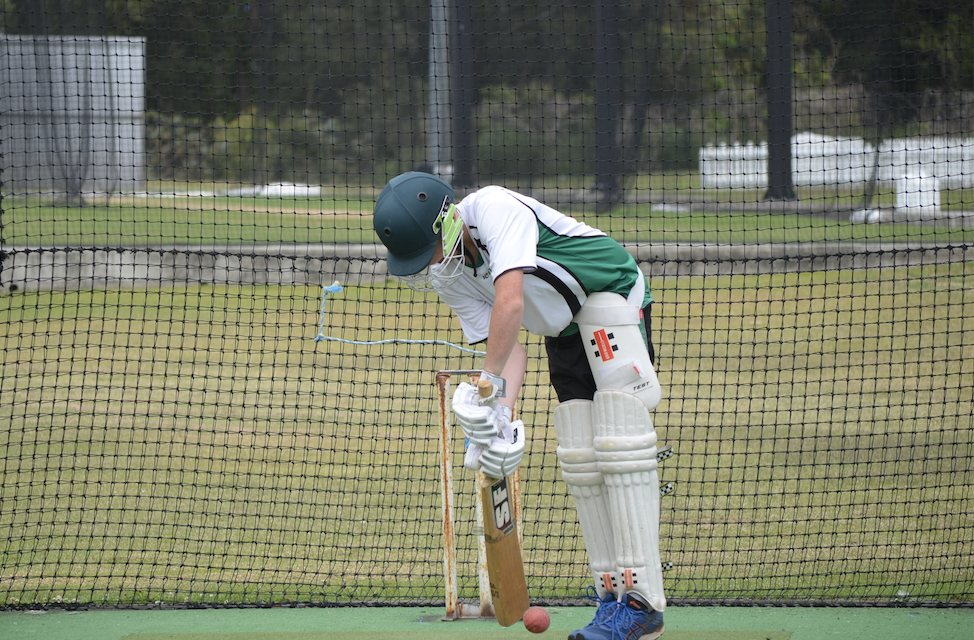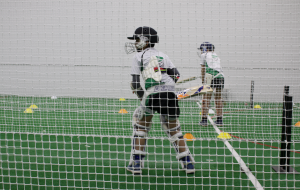Your ability to read a batsmen and identify flaws in their game and technique is critical in enabling you to develop effective plans to that batsman.
Is it solely the bowlers job to read batsmen?
Of course not. It’s a combined effort between bowler, keeper, captain, coach and fielders.
Here are six technical errors, how to spot them in batsmen and what line and length is best to bowl if you identify a batsmen with the error.
1. CLOSED GRIP
A closed give is a deficiency in the way a batsman holds the bat.
IDENTIFY
There’s a couple of things to look out for here…
Firstly, where the batsman’s bottom hand is on the bat. If they have a closed grip their bottom hand will be right around on the handle.
Picture when you pick up a bat - ideally you want to line the V’s between our thumb and forefinger up somewhere down the outside half of the bat.
If a batsman has a closed grip their bottom hand will slide around towards them and their V will be aligned somewhere down the inside half of the bat.
The second thing to look for is where the face of their bat is in their back lift.
With a standard grip the face of the bat should point out to the offside somewhere between 2nd slip and point.
With a closed grip the face of their bat will point to the ground, back at the keeper or even slightly to leg stump.
HOW TO BOWL
Players with a closed grip a generally bottom hand dominant and because of the angle of their bat they’re stronger through the leg side.
They generally find it difficult to hit through the off side.
If you bowl a little bit wider outside off stump it’s going to make it very difficult for them to score and create a lot of pressure.
2. LUNGING ON FRONT FOOT
This is when a batsman commits to a big step onto the front foot towards the off side before you have released the ball.
IDENTIFY
Obviously a reasonably easy one to spot.
You’ll be able to see it in your delivery strip but make sure your keeper and slips are on the ball too.
If they’re taking a big stride before you release the ball then you’ve got yourself a candidate.
HOW TO BOWL
Batsmen that do this are a big chance of getting trapped in front (LBW). Once they commit to the front foot it’s very hard to move it and their front pad can get in the way to straighter balls.
If they’ve just come in, set a straight field - give yourself some protection on the leg side and bowl a little bit straighter. You’re a big chance of pinning them early before they get their eye in.
If they’re set when you come on to bowl, I normally like to try and set them up. My plan would be to drag their front foot further and further across their stumps and then spear one in a bit quicker.
The over would look something like this…
4th stump 85% pace, 5th stump 85% pace, 5th stump 85% pace, 6th stump 80% pace, middle/off stump 100% pace - (hopefully wicket)!
That’s a very simple example but hopefully you get what I’m saying there.
The other option (only if you’re quick enough) is to bowl short - because they’re lunging on the front foot they’ll have less time to play the ball and can get in a tangle against short balls.
3. WEIGHT BACK - HALF STEP FORWARD
On the flip side - you’ll come across batsman that hang right back and only take small steps forward.
IDENTIFY
Again, pretty simple…if they bat deeper in their crease and don’t commit their weight forward to full balls you’ve got yourself a back foot player.
There’s two reasons batsmen do this…
- They’re timid and have a fear of short balls.
- They’re really strong square of the wicket and are sweating on short balls.
HOW TO BOWL
If you think it’s because they’re timid you can bowl aggressively at them.
Bowl a shorter length, push them right back in their crease and then bowl the odd full ball trying to get knicks, bowled’s & lbw’s.
If it’s because they’re really strong square of the wicket they generally won’t hurt you down the ground so you can bowl a fuller length.
Take their strength away from them and get them driving the ball.
4. FRONT FOOT STRAIGHT DOWN WICKET
IDENTIFY
This is when a batsman takes a step straight down the line of middle stump to a full ball no matter what the line of the ball is.
Take notice when they first come in where their foot goes to fuller balls outside off stump.
If it’s always straight down the wicket then you might have yourself a ‘knicker’
HOW TO BOWL
If their foot is going straight down the wicket then they’ll likely be stronger to straighter balls. If the ball is a little bit outside off they’ll be playing the ball outside their eye line and their hand will be going away from their body.
Don’t bowl too wide but if you’re consistently around 4th-6th stump line you’ll be a big chance of getting a knick.
5. BACK LIFT TO FINE LEG
IDENTIFY
Ideally a batsman back lift should go somewhere between 1st-3rd slip. Any wider and they’ll be chopping in on the ball.
What we’re looking for is when the batsman’s back lift goes behind their body and points to fine leg.
HOW TO BOWL
If their back lift is pointing to fine leg it generally means their shoulders will be aligned to the off side as well.
This puts them in a great position to hit cover drives. Anything outside the off stump they’ll generally smoke!
Anything straight they’re in a very vulnerable position for.
If you picture it they kind of have to swing their bat in a semi circle to get it around to access the leg side.
Bowl straighter - middle/off stump line and you’re a big chance of an LBW.
6. HEAD FALLING TO OFF SIDE
IDENTIFY
This is a really common one and happens in a sequence - like dominoes!
It looks like this - hands go away from body in back lift to gully/point > head follows to the off side > front foot follows across to off stump a a balancing mechanism.
This means all of their weight is going to the off side.
HOW TO BOWL
Again, the position they get themselves into really lends itself to hitting through the offside.
Anything just outside off stump or wider they’re going to feel really comfortable with.
Where they won’t feel so comfortable is anything on the stumps.
With the position their hands are in and their weight planting their front foot on the off stump they’re going to find it very difficulty to hit straight and will have to play across the line to straighter balls.
This means you’re a massive chance of an LBW!

I hope that helps you identify some possible errors in batsmen you’re bowling to as well as develop some plans.
Remember these a general plans that I’ve found work to MOST batsman.
Every batsman is different and may eat up the bowling plan I’ve suggested, you’ll have to use your game awareness and try to identify where a batsman might struggle.
Good luck and as always would love to hear any that’t you’ve picked up along the way that I haven’t mentioned.
Author: Nick Fitzpatrick
ACI Co Founder & Coach



